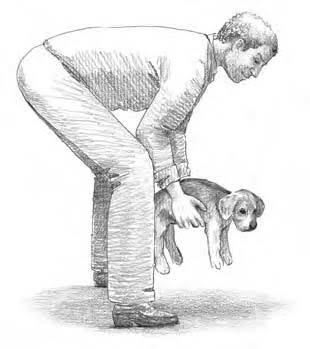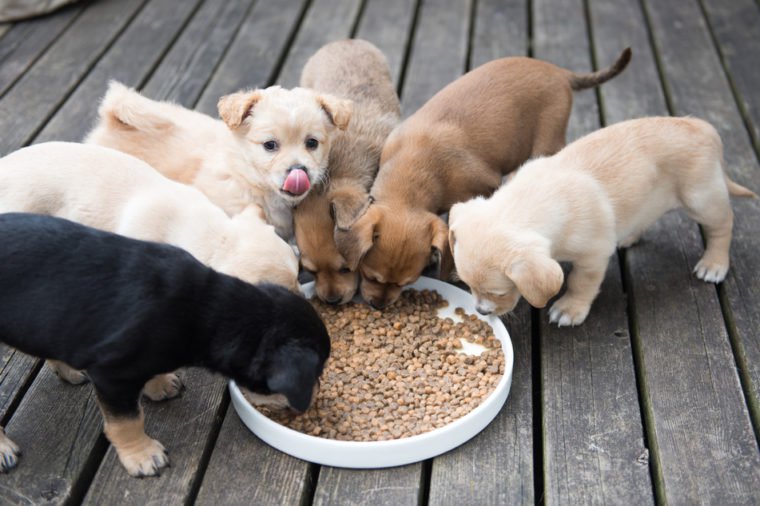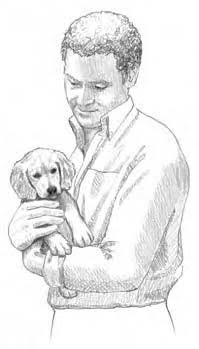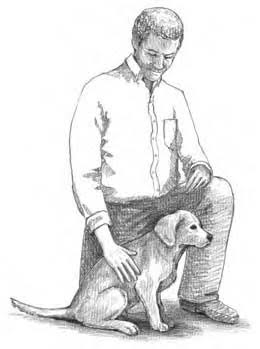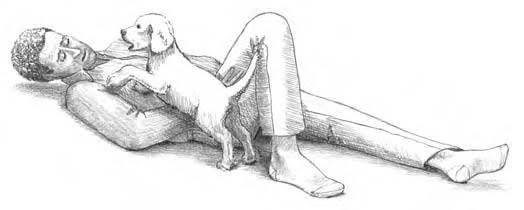In This Chapter
- Deciding where to look for your puppy — breeders, shelters, newspaper ads, or pet stores
- Asking and answering all the right questions about your prospective puppy
- Testing your puppy’s temperament and personality
- Considering an older pup
Let the search begin! You can find a puppy in so many places, from serious breeders of purebred dogs to ads in the newspaper. To ease the stress of finding your perfect puppy companion, consider all your options, noting pros and cons of each, and then scout out and test as many puppies as you need to until you find the one whose breed impulses and personality best match your own. Nothing is more disappointing (for you and the pup) than bringing a puppy home and it not working out. That pitfall can be avoided with many of the tips found in this very chapter.
Where’s the Puppy Coming From?
Remember
When considering the various options open to you, be mindful of what you’re getting into. Some puppies who are stressed at an early age mellow out and develop a high tolerance for chaos — making them ideal for chaotic, unstructured homes. Other dogs, however, can’t handle the stress and flip out when things don’t follow their routine.
Breeder
– Genetic defects: These defects are passed down from parent to pup and can result in a host of maladies from hip dysplasia to heart murmurs. A conscientious breeder tests each parent before breeding them to ensure they’re clear of these congenital defects. As you research each prospective breed, list possible defects and question the breeder’s awareness before looking at his puppies.
– Line breeding/breeding for show: Breeders of show dogs mindfully try to “create” puppies who, when grown, adhere to the breed standard. This becomes an issue when a breeder breeds relatives who may look beautiful but are closely related to one another. The puppies are often a neurological mess or totally spacey, or in other words, aggressive or dumb.
Tip
If you’re interested in a puppy for show, you could overlook temperament for beauty, but if personality matters to you, skip a breeder whose pedigrees show the name of a dog repeated again and again. The rule of thumb is that five generations should separate one relative from another.
Technical Stuff
In the United States, a breed standard is documented by the American Kennel Club. Pages are written listing each breed’s specific ideal characteristics from coat color and personality to the skeletal carriage and direction of each toe. Each detail is very precise, and perfection is the golden chalice every show-oriented breeder reaches for. However, if you’re getting your puppy just to be the ideal family pet or companion, a maligned freckle or slightly offset toenail won’t matter at all!
– Breeding for temperament: When a breeder says he’s breeding for temperament, you know you’ve found a reputable one. Breeding for temperament means he’s just as interested in delightfully-acting puppies as ones that look good. If you’re getting your puppy to be a pet, this attribute in a breeder trumps all others.
Finding a breeder who breeds for temperament is also important when choosing a breed whose skills won’t be in high demand. Unless you want to wake at the crack of dawn to go hunting with your retriever or sledding with your Siberian Husky, finding a breeder who’s more mindful of temperament than skills is step number one.
– Temperament testing: A temperament test is a series of handling exercises performed on a puppy who’s 7 weeks of age or older. These handling exercises are designed to enable you to predict the future temperament of your chosen puppy. They also provide a fairly accurate assessment of a puppy’s personality and eventual adult demeanor, from dominant and bossy to shy and withdrawn. Later in the chapter, I include a temperament test that you can use on all your prospective puppies. However, you’ll find that many breeders perform these tests on their puppies before placement.
Remember
Finding breeders to help you understand both the positives and negatives of the breed they work with is worth their weight in gold. If they’re serious about the placement of their puppies, they’ll ask you a whole list of questions. You may feel more scrutinized than if you were adopting a child, but don’t be put off by their questions because in the end, you’ll end up with a puppy who has been loved and well cared for since its very first breath.
Tip
Go with your gut. If you drive up to a breeder’s kennel and get a bad vibe for any reason, such as dirty facilities, odd mannerisms, or not being allowed to see your puppy’s mother (or father, if he’s on the premises), leave. The urge to save a puppy from this environment will be overpowering, but go with your gut because ending up with a sickly or poorly socialized puppy is an emotionally wrenching experience that may not end well for you or your puppy. In addition, you can call the local chapter of the American Society for the Prevention of Cruelty to Animals (ASPCA) to report them, which helps put people who are breeding purely for financial gains out of business.
Home breeder
– If they’re purebred puppies, ask whether the pup’s parents were tested for genetic defects known to the breed and whether you can meet the parents.
– If they’re mixed breed puppies, ask whether the mix of breeds is known or has been speculated.
– Ask how old the puppies will be when they’re sold or given to a good home.
Warning!
Don’t adopt a puppy younger than 8 weeks old. Seven weeks is the exception, and that’s only if you’re a seasoned dog owner. You don’t want to adopt before 8 weeks old because a pup’s mother would normally spend weeks 6 through 8 socializing and teaching her puppies. The result of this socialization is good for you because the puppies will have more organized elimination habits, respect, and bite inhibition.
Shelter
Remember
Going to a shelter to look for your puppy is a noble deed. Prepare yourself, however, because you’ll see some faces that’ll show up in your soup for a while. Even though you’ll feel the temptation to take them all home, you can’t. You’ve come for one puppy — your ideal puppy — and if you don’t find him that first day, plan to come back.
– Do you have any history on the puppies?
– Have you spent time with the puppies? What do you think of their different personalities?
– Have the puppies been introduced to children or cats? If so, what was their reaction?
Tip
If you have other pets or kids, I recommend examining a potential puppy’s reaction to them. Nothing is more disappointing than having to bring a puppy back.
Remember
Consider how each breed in the mix will fit into your lifestyle. For instance, if you’re looking for a low-shedding, small- to medium-size dog who will sally up to anyone, pass on the Chow-Akita mix, no matter how cute he looks sitting there in the cage. As an adult, he’ll be large and aloof to strangers and will have heavy shedding seasons — and those characteristics don’t match your initial description at all!
Pet store
Warning!
More mindful breeders who choose to send their puppies out for resale don’t usually send the pet stores the cream of their litter. The puppies they send are usually undersized or of poor conformation, from an ankle joint that’s out of place to an undershot jaw. Resale breeders aren’t likely to spend money to ensure their breeding dogs are free from genetic defects.
Tip
If you find yourself with a really young pupIf you find yourself with a puppy younger than 8 weeks old, do your best to mimic both the consistency and structure of a mother dog, and socialize your puppy with a healthy, inoculated, patient dog who will aid you in those early life lessons. If you have a young puppy, use some of the many soft handling techniques that mirror his mother’s nurturing. These techniques, which will bring him to near nirvana, can be practiced at any age throughout his life.
|
Tip
If you’re considering the pet store option, spend a little extra time finding a reputable pet store. A pet store’s reputation can be measured by the friendliness of the staff toward their puppies, their knowledge of individual breeds, their interest in your situation, and their willingness to let you communicate with the puppy’s original breeder.
Observing a Pup with His Littermates
Bite inhibition
Tip
You can replicate this littermate communication by yelping “Ouch” when your puppy bites too hard. If your puppy doesn’t pull back, take his collar or leash and pull him away from your body. Don’t push or shove your puppy because physical reactions are interpreted as confrontational play. For more help with a nipping pooch, refer to Chapter Dealing with Daily Hassles.
Who makes the rules?
Tip
To be Top Dog in your house, get started at home immediately. By using the command “Excuse me” (see Chapter Training through Your Pup’s Growth Stages), you communicate loads in terms of your overall leadership.
The Art of Selecting Your Puppy
Remember
If you’re testing an 8-week-old puppy, remember that his brain won’t be fully aroused or awake until he’s 12 weeks old. Try to schedule your visit just before feeding or stay for a few hours to watch him during various activities. Test your puppy when he’s active, not when he’s tired or sleepy.
Two puppies: Twice the fun or double the trouble?The answer to that question depends on how much time and patience you have. If you’re short on either, don’t overextend yourself. Two puppies, unless coddled and trained separately within your home, will bond to each other more than they will with you. Mischief peaks to a whole new level when puppies plot trouble together. Housetraining two puppies simultaneously is also quite a chore. If you want to have two dogs, I suggest raising one, and after a year, bringing home your “second child.” If you really feel up for the challenge of two puppies, though, you’ll have the best chance for success with a male and a female or with two males (as long as they don’t share strong, dominant temperaments). Two females can become hormonal and difficult. Also, when selecting the personalities, don’t pick the extremes. You’ll get polar opposites — one who’ll bully and overshadow, while the other shakes in the corner. |
2 Getting into the testing mindset
– With the breeder/home breeder: Often a breeder will tell you when to come by. If not, ask about the puppy’s schedule and how long you can stay. Ideally, you want to visit when the puppies are awake and playful. Avoid nap times or late-night visits. When possible, ask to stay for a couple of hours so that you can watch and interact with the litter over an extended period of time.
– At a shelter: When you speak with the staff members, ask them how many puppies are available for adoption and if they know the breeds or mix of breeds. Ask whether the shelter has a litter of puppies or just individual pups. Also ask the staff whether they know when the puppies were separated from their mother and where the puppies came from. Early stress can backfire, sadly making a pup nervous or impulsive.
Tip
Find out whether the puppies are allowed to interact with each other and at what time. Ideally, you want to see your candidate interacting with littermates or other puppies to determine his sociability within a group.
– At a pet shop: Pet shop puppies are often shipped alone or with one or two siblings. After they arrive, they’re either crated alone or with a puppy of another breed. This is a very confusing situation for a young puppy to be in, and because of this stress, many of the puppies may seem dulled by the experience. When isolated in a greeting room, however, you’ll be better able to test his personality.
Tip
If you’re serious about one puppy in particular, spend at least 30 minutes with him. You should interact, hold, and play to get an overall view of his personality. In addition, bring other puppies into the room to discern his sociability with peers.
An outsider looking in: Personality profiling
– Bully: On first glance, the bully may seem overtly social and interactive. You may think “Good, that one has spirit.” However, keep watching. Does he steal the toys from the other puppies, or does he play too rough? Does he scale the enclosure or climb on the backs of his littermates as though they don’t exist?
These are sure signs of determination, smarts, and will power, but you have to decide how those characteristics will mesh into your home life. If you have the time to channel (and challenge) this puppy, take him home! However, if you have other demands on your time and you’re hoping for a puppy to reduce your stress, pass on the bully.
– Rebel Rouser: Puppies in this group are quick-thinking, fun-loving, and engaging puppies. They hold an equal fascination with toys and play as their bullying brethren, but they’re clearly more sensitive. In fact, the bully and the rebel rouser may be seen playing together with the rebel rouser taking the submissive roll when the bully flexes his muscles (in “Doglish” this may be seen by a belly roll or head pinning).
Rebel rousers are engaging without being too headstrong. This is an ideal temperament for an active person or family with older children.
– Independent Thinkers: These puppies tolerate and interact in playful encounters some of the time but are also happy sitting or playing with a toy on their own. Stoic and contained, these independent thinkers seem to have been born with an old soul.
These pups are ideal in a structured home where owners fully respect their sense of self and make a commitment to teach them. Because they’re mindful and alert, these puppies are ideally placed in calm homes, with older or no children.
– Eager to Please: This lot is eager to please and is always interested in your opinion. This attitude can lead them to the head of the class or into the doghouse depending on how you play it. If you direct and reinforce good manners, you’ll have more than 100 percent cooperation. On the other hand, if you try to correct your puppy’s naughty behavior, he’ll see your interaction as a reason to replay it over and over and over.
Remember
Because of their trainability, these puppies are wonderful companions, but they can end up on the B list if they don’t receive direction.
– Just Chillin’: This relaxed lot beautifully balances play, interaction, and sleep — doing all three on their own time. Perhaps less intelligent than their more active siblings, pups with this personality type simply do what they want, when they want.
These puppies may sound dreamy, but remember, motivating them takes some creativity. They’re not ideal for controlling owners, but they complement a relaxed household and fit beautifully into a home environment with young children, provided the breed is suitable (see Chapter Pre-Puppy Considerations if you need help selecting a breed).
– Sweetie Pie: Soft-natured and gentle, these puppies are most often seen under the other puppies who are taking advantage of their docile nature. These pups are also passive and eager to please, so their sweetness will be palpable. Within their litter, these puppies stay close to their mother and use her protection as a shield.
This personality is for those owners who prefer doting attention over rigorous training. Puppies with this personality are less likely to roam because staying close to home will be a top priority.
– Timid: These puppies, who are clearly not born with a strong sense of self, may appear to have been abused, even though it’s more symbolic of their dislocated character than misguided nurturing. When approached, they often creep on their bellies or arch their back in total submission.
Your heart may go out to pups with this personality, but only select this type of puppy if you have the time and patience to devote to fostering their self-esteem.
Remember
Regardless of your effort, timid puppies may always be overwhelmed and in need of direction, so they aren’t a suitable choice for families with children.
Temperament test: Take it along!
Using the score card
Remember
Active puppies are smart and interactive, which means a lot of work but also a lot of fun. Spirited and intelligent, active pups are well appreciated by those owners who have the time and determination needed to train them. Neutral puppies are relaxed and undemanding — sort of the regular guys of the dog world. Passive and shy puppies appreciate love and support but are fearful of change, so they do best in consistent environments.
Puppy Assessment Form | |||||||||||
Name/ Number of Pub | 1. Observe | 2. Play | 3. Cradle | 4. Call Back | 5. Tuck & Pat | 6. Bend Over | 7. Nose Kiss | 8. Toe Squeeze | 9. Startle Sound | 10. Crash Test | 11. Uplift |
Performing the tests
1. Observe.
You can tell a lot about your puppy before you’ve even said hello. Watch your puppy if he’s playing with other puppies. What is his personality? Is he bullying or being bullied? Does he prefer jumping into group activities (A), hanging in the midst of the activity (N), or staying on the sidelines (P)? Is he stealing the bones (A) or submitting when approached (N or P)? After you’ve observed the pup for a few minutes, assign him a score in the first column.
2. Play.
When you first take a puppy aside, play with him. Is he hyper (A), easygoing (N), or does he just want to be petted (P)? Bring out some toys. Does he show interest in them? Does he show you what he has (N), instigate tug of war (A), or covet the object immediately? Coveting is an early sign of possessiveness, which may lead to aggression.
I brought a Frisbee when I was searching for a dog who would catch and retrieve. Ask yourself what’s important to you.
3. Cradle (see Figure 4-2).
Cradle your puppy in your arms. Does he relax (P), wiggle a bit and then relax (N), or kick like crazy (A)? Which action matches your expectations?
Don’t choose an A type if you have children.
4. Call back.
Using a treat or a squeak toy, call to your puppy as you back away from him. Does he race after you while jumping or nipping your ankles (A), follow happily (N), or hesitate and need coaxing (P)?
5. Tuck and pat (see Figure 4-3).
Kneeling on the floor or sitting in a chair, settle the puppy between your legs. Pet him in long gentle strokes as you praise him softly. Does he wriggle free as he nips (A), wriggle and then relax (N), or simply melt in your embrace (P)?
6. Bend over.
Stand up, stretch, and relax. Now go to your puppy and lean over to pet him. Your doing this may seem overwhelming to the pup because you’re so large and he’s so small. Does he jump up to your face (A), cower in confusion (P), or just relax and let it happen (N)?
7. Nose kiss.
Cradle your puppy’s face in your hands and kiss him on the nose. Does he bite you back (A), accept the smooch calmly or return the interaction with a soft bite or kiss (N), or pull back in confusion (P)?
8. Toe squeeze.
In this exercise, you’re testing your puppy’s reaction and sensitivity to discomfort. While petting the puppy, gently squeeze the skin between his toes. Does he attack your hand? If so, he’s definitely an A type with high sensitivity. A neutral puppy may lick or mouth gently, whereas a passive puppy will cringe fearfully.
9. Startle sound.
Take a bunch of keys, and when your prospective puppy least expects it, rattle them above his head. Gauge his reaction: Attacking the keys gets an A; a nonchalant glance, an N; and a fear reaction noted by cowering or withdrawal, a P.
10. Crash test (see Figure 4-4).
Stand and wait until your puppy is no longer interested in you. Suddenly fall to the ground as if you’ve tripped and exclaim “Ouch!” Does the puppy race over and pounce (A), come to sniff or lick your face (N), or cower and run in fear (P)?
11. Uplift (see Figure 4-5).
Lift your puppy 4 inches off the floor by cradling his midsection. Hold him there for at least 5 seconds. Does he wriggle and bite furiously (A)? Does he relax and look around (N)? Does he look fearful and constrict his body posture (P)?
Rating the results
– All A’s: This dominant puppy is bright and interactive. Raising him will take concentration, consistency, and time. His favorite expression: “What’s Next?”
– All N’s: Easygoing and contained, this puppy will be pleasant and selfassured, though perhaps not terribly motivated to follow your agenda when it conflicts with his own. His favorite expression: “Is this absolutely necessary?”
Tip
Involve the kids and other pets in the puppy selection processIf you have children or other pets, and you can involve them, do so. Some facility staff or breeders may balk, but try to persuade them. You want your puppy to succeed in your home environment, and that means getting along with your sometimes disgruntled resident Schnauzer or your shy 6-year-old son. Finding a puppy that best suits their temperaments can be a plus because not every puppy personality will jive with them. Children over 5 years old can take part in the exercises, and other pets can be introduced after you’ve narrowed your choice. |
– All P’s: This puppy has a weak self-esteem and needs your reassurance to feel safe. Without proper lessons and socialization, he’ll be shy. His favorite expression: “It’s been three minutes, do you still love me?”
– Mix of A and N: This active puppy will want to be in the middle of everything but will show slightly more impulse control when stimulated. His favorite expression: “Let’s do it again!”
– Mix of N and P: This self-assured puppy will be easygoing and gentle yet with a stronger sense of self than a completely passive pup. Because he’s more composed, he’ll be an ideal puppy for a calm house with or without older children. Favorite expression: “Another backscratching please!” If you’ve found a puppy whose score matches what you’re looking for, great!
Remember
If not, you’re going to need to keep looking. Don’t get discouraged, and don’t settle for a puppy who doesn’t quite suit you just because you’ve been looking for a long time. I’ve been there — finding the right puppy is worth the wait!
Going for an Older Puppy?
Considering the source
– Breeder: A breeder often keeps a puppy for showing purposes. If the puppy doesn’t grow into “show dog” potential, he’ll be placed in a home. Sometimes it’s like hitting the jackpot, provided the puppy has had individual attention and has been well socialized. Other times, it’s a disappointment, especially if the puppy has lived in a kennel for the last six months.
Remember
Because a breeder’s older puppy may be unfamiliar with the routines of home life, he may not know what stairs are or may not have spent time in a yard. And, no matter what they try to tell you, a puppy who has spent the majority of his time in a kennel isn’t housebroken! Find out where this puppy spent his early months before racing into this venture. A puppy who can’t emotionally acclimate to your home life isn’t a reasonable candidate for you.
– Pet store: These puppies usually sell for a discounted price after they’ve grown out of their cute phase. Though your heart (and mine) goes out to each of them, consider their reality before you adopt. A virtual lifetime spent behind bars can take an emotional toll, and housebreaking will be a project because they’ve not been introduced to the concept of “holding it.” It’s also likely that this puppy has had little, if any, exposure to home living, from everyday sounds to stairs, grass, and cars.
Once a puppy is beyond that peak socialization period, you risk raising a pup who won’t warm to everyday stimulations. Some older puppies who get adopted may turn out fine, but you’re always going to run a risk.
Warning!
A puppy who was stressed during infancy chews more often than other pups. Nervous energy needs to be displaced, and because running to the refrigerator is off limits and nail biting isn’t an option, they chew on whatever is available. Provide plenty of satisfying options or you may see your sofa disappear, one cushion at a time.
– Shelter: If you find an older puppy at a shelter, ask about his history. Was he found on the side of the street, or has he grown up in the system? Was he tied to a post or brought in by a good Samaritan? Has the puppy in question been returned more than once? Ask what the reasons were and what the staff thinks of the puppy’s personality.
Guidelines for testing older pups
– If you have kids, make sure you introduce them to the puppy before you bring him home.
– Startle the puppy. Toss your keys on the floor. Does the puppy fall to pieces or attack them? Neither is a good reaction. A startled reaction to the noise, followed by an investigative sniff, is an ideal response.
– If you have an animal menagerie at home, make sure the puppy can cope with the creature chaos. Ask whether other animals are in the owner’s current home, or whether anyone has conditioned this puppy to other creatures.
– Ask one of the staff members (or the previous owner) to lift the puppy. What happens? Intense fear or frustration isn’t a good sign. The ideal puppy may squirm but is still accepting.
– Bring a soft brush and try to groom the pup while feeding him treats.
Remember
Bear in mind that older puppies are less accepting of strangers and strange situations than infant pups, so allow some room for edginess. But, if you see anything more extreme, back off, especially if what you see is aggression. Unless you want a major training project, look for a puppy who’s accepting of you and each of the exercises or conditions mentioned in the previous list.
Sarah Hodgson




